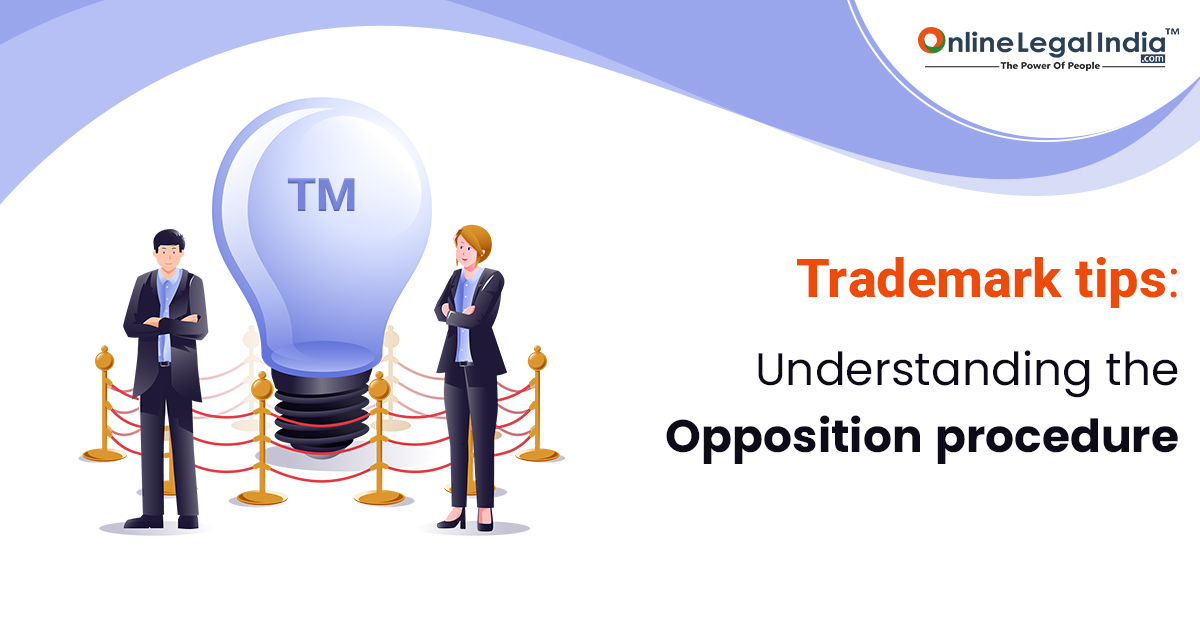GSTR 9C – Applicability, Due Date, Turnover Limit
18 Jul, 2025

 By Online Legal India
Published On 31 Aug 2022
Updated On 17 Jun 2025
Category Trademark
By Online Legal India
Published On 31 Aug 2022
Updated On 17 Jun 2025
Category Trademark
The trademark opposition proceeding serves as a critical mechanism in India’s trademark registration process, ensuring that new trademarks do not infringe upon existing rights or cause confusion among consumers. Once a trademark application is published in the Trademark Journal, it enters a phase where third parties have the opportunity to contest its registration. This opposition process is governed by the Trade Marks Act, 1999, and the Trade Marks Rules, 2017, which outline specific procedures and timelines for both applicants and opponents. Understanding the intricacies of this process is essential for businesses and individuals aiming to protect their brand identities and uphold the integrity of trademark registrations in India.
Trademark opposition in India is a legal mechanism that allows individuals or entities to challenge the registration of a trademark they believe may infringe upon their rights or cause confusion among consumers. This process is governed by the Trade Marks Act, 1999, and is a crucial step in ensuring that only distinctive and non-conflicting trademarks are granted registration.
Under Section 21 of the Trade Marks Act, 1999, the right to oppose a trademark application is extended to "any person." This broad definition encompasses a wide range of individuals and entities. It ensures that the trademark registration process remains transparent and fair.
The term "any person" is inclusive and not limited to direct competitors or trademark owners. It allows various parties to file an opposition if they believe that the registration of a particular trademark would adversely affect their interests. Eligible opponents include:
This inclusive approach ensures that the trademark registration process considers the interests of all stakeholders, maintaining the integrity of the marketplace.
Trademark opposition in India can be based on absolute or relative grounds as outlined in the Trade Marks Act, 1999. Absolute grounds focus on the inherent characteristics of the mark, such as lack of distinctiveness, descriptive or generic nature, use of customary terms, or inclusion of offensive content. Relative grounds relate to conflicts with trademarks that already exist. This includes similarity to registered marks that may cause confusion or deception among consumers. Additionally, marks applied for in bad faith or those prohibited under specific laws, like the Emblems and Names Act, 1950, can also be opposed.
1. Absolute Grounds for Opposition (Section 9 of the Trade Marks Act):
If the trademark is not capable of distinguishing the applicant's goods or services from those of others, it can be opposed. This includes descriptive marks, generic terms, or marks that are primarily surnames.
If the trademark is likely to deceive or cause confusion among the public, it can be opposed.
Trademarks containing scandalous, obscene, or immoral matter are not registrable and can be opposed.
If the trademark is contrary to law or morality, such as hurting religious feelings, it can be opposed.
If the trademark is prohibited under any specific law, like the Emblem and Names Act, 1950, it can be opposed.
2. Relative Grounds for Opposition (Section 11 of the Trade Marks Act):
If the trademark is identical or confusingly similar to an existing registered trademark, it can be opposed. This includes considering the similarity of goods or services and the likelihood of confusion.
If the trademark is likely to cause confusion or association with a prior registered trademark, it can be opposed.
If the trademark is similar to a well-known trademark and is likely to dilute its distinctive character or reputation, it can be opposed.
If the trademark application is made in bad faith, such as to block another party from using the mark, it can be opposed.
3. Other Relevant Grounds:
If another party has been using the trademark (or a similar mark) prior to the application, it can be a ground for opposition.
If the applicant is only a licensee of the trademark, opposition can be raised.
If the trademark is customary in the current language or established business practices, it can be opposed.
If the trademark conflicts with a registered geographical indication, it can be opposed.
The trademark opposition process in India is a structured legal procedure that allows any person to challenge the registration of a trademark after its publication in the Trademark Journal. The steps involved are as follows:
An opposition must be filed within four months from the date the trademark application is published in the Trademark Journal. The notice, submitted using Form TM-O along with the prescribed fee, should detail the grounds for opposition and relevant information supporting the claim.
Upon receiving the notice of opposition, the trademark applicant is required to file a counterstatement within two months. This response, also filed using Form TM-O, should address the allegations made in the opposition and provide supporting facts. Failure to submit a counterstatement within the stipulated time results in the abandonment of the trademark application.
The evidence that must be submitted by the parties are mentioned below:
Within two months of receiving the counterstatement, the opponent may submit evidence supporting the opposition. This is typically done through an affidavit and accompanying documents. Alternatively, the opponent can choose not to submit additional evidence and rely solely on the contents of the notice of opposition.
After the opponent's evidence is submitted or waived, the applicant has two months to provide evidence supporting the trademark application. This can include affidavits and other relevant documents. The applicant may also opt to waive the submission of additional evidence and rely on the counterstatement.
The opponent has the option to file rebuttal evidence within one month after receiving the applicant's evidence. This stage is optional and allows the opponent to address points raised by the applicant.
Once the evidence stages are complete, the Registrar schedules a hearing and notifies both parties. During the hearing, both sides have the option to present their arguments in front of the registrar. If either party fails to appear, the Registrar may decide in favor of the present party. After considering all submissions, the Registrar issues a written decision, either allowing the trademark to proceed to registration or rejecting the application.
Trademark opposition is a time-sensitive legal process in India. Missing deadlines can lead to the abandonment of your application or opposition. Here is a step-by-step breakdown:
Once a trademark is published in the Trademark Journal in India, any person can oppose its registration by filing a notice of opposition within four months from the publication date. If no opposition is filed within this period, the trademark proceeds to registration without further challenge. After registration, the only recourse to contest the trademark is through rectification proceedings, which are more complex and time-consuming. Therefore, it is crucial to act within the stipulated four-month window to safeguard your interests.
Upon receiving a Notice of Opposition to a trademark application in India, the applicant is required to file a counterstatement within two months. This response must address the allegations made in the opposition and provide supporting facts. Failure to submit the counterstatement within this stipulated period results in the application being deemed abandoned, with no provision for extension.
The trademark opposition process involves strict timelines for the submission of evidence by both parties in India. After the applicant files a counterstatement in response to the notice of opposition, the opponent has a statutory period of two months to submit evidence supporting the opposition or to rely on the counterstatement by submitting a letter of reliance. If the applicant fails to submit evidence or a letter of reliance within this timeframe, the application may be deemed abandoned.
The opponent is then allowed an additional one month to file rebuttal evidence in response to the applicant's evidence. Failure to submit rebuttal evidence within this period may result in the Registrar considering the applicant's evidence as unchallenged.
It's important to follow these deadlines carefully. Missing any of them could mean you lose the chance to oppose a trademark or complete your application. This could result in your trademark being rejected or someone else's being approved without challenge.
To complete the opposition, you should better hire an advocate to fight for you and help maintain all legal procedures.
Engaging legal professionals or consultants in the opposition process offers significant advantages that can enhance the likelihood of a successful outcome.
Legal professionals possess in-depth knowledge of the opposition process. This includes filing requirements, deadlines, and procedural nuances. Their expertise ensures that all necessary steps are correctly followed, which reduces the risk of procedural errors that could jeopardize the case.
Experienced attorneys can develop effective strategies tailored to the specific circumstances of the case. They can assess the strengths and weaknesses of the opposition, anticipate potential counterarguments, and formulate persuasive arguments to support their client's position.
Opposition proceedings can involve complex legal and factual issues. Legal professionals are equipped to navigate these complexities, interpret relevant laws and regulations, and apply them effectively to the case at hand.
In hearings or negotiations, having a legal representative ensures that the client's interests are effectively advocated. Attorneys can present evidence, cross-examine witnesses, and make compelling legal arguments on behalf of their clients.
Studies and professional experience indicate that parties represented by legal professionals have higher success rates in opposition proceedings. The combination of legal knowledge, strategic planning, and effective advocacy contributes to more favorable outcomes.
Trademark opposition proceedings play a vital role in protecting existing brand rights by allowing third parties to challenge a new trademark before it's registered. This legal process ensures that similar or conflicting marks don’t get approved, which could confuse consumers or harm established brands. Participating in a trademark opposition proceeding helps maintain market clarity, prevent infringement, and safeguard your brand identity in a competitive business environment.
Securing your brand through trademark registration is crucial in today's competitive market. Online Legal India offers expert assistance to make this process seamless and efficient. Our experts also guide you during the process of trademark opposition proceedings in India. Our services include comprehensive support for trademark registration. This ensures your brand's identity is protected from potential infringements. With a team of experienced professionals, we guide you through every step, from application to final registration, minimizing errors and delays. Visit Online Legal India today.